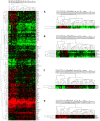Pathway analysis of primary central nervous system lymphoma
- PMID: 18184868
- PMCID: PMC2265457
- DOI: 10.1182/blood-2007-10-119099
Pathway analysis of primary central nervous system lymphoma
Abstract
Primary central nervous system (CNS) lymphoma (PCNSL) is a diffuse large B-cell lymphoma (DLBCL) confined to the CNS. A genome-wide gene expression comparison between PCNSL and non-CNS DLBCL was performed, the latter consisting of both nodal and extranodal DLBCL (nDLBCL and enDLBCL), to identify a "CNS signature." Pathway analysis with the program SigPathway revealed that PCNSL is characterized notably by significant differential expression of multiple extracellular matrix (ECM) and adhesion-related pathways. The most significantly up-regulated gene is the ECM-related osteopontin (SPP1). Expression at the protein level of ECM-related SPP1 and CHI3L1 in PCNSL cells was demonstrated by immunohistochemistry. The alterations in gene expression can be interpreted within several biologic contexts with implications for PCNSL, including CNS tropism (ECM and adhesion-related pathways, SPP1, DDR1), B-cell migration (CXCL13, SPP1), activated B-cell subtype (MUM1), lymphoproliferation (SPP1, TCL1A, CHI3L1), aggressive clinical behavior (SPP1, CHI3L1, MUM1), and aggressive metastatic cancer phenotype (SPP1, CHI3L1). The gene expression signature discovered in our study may represent a true "CNS signature" because we contrasted PCNSL with wide-spectrum non-CNS DLBCL on a genomic scale and performed an in-depth bioinformatic analysis.
Figures






Comment in
-
Differential gene expression in central nervous system lymphoma.Blood. 2009 Jan 1;113(1):266-7; author reply 267-8. doi: 10.1182/blood-2008-04-152835. Blood. 2009. PMID: 19122120 Free PMC article. No abstract available.
Similar articles
-
Preferential up-regulation of osteopontin in primary central nervous system lymphoma does not correlate with putative receptor CD44v6 or CD44H expression.Hum Pathol. 2013 Apr;44(4):606-11. doi: 10.1016/j.humpath.2012.07.007. Epub 2012 Oct 22. Hum Pathol. 2013. PMID: 23089492
-
Microarray Gene-expression Profiling Analysis Comparing PCNSL and Non-CNS Diffuse Large B-Cell Lymphoma.Anticancer Res. 2015 Jun;35(6):3333-40. Anticancer Res. 2015. PMID: 26026093
-
Differential micro-RNA expression in primary CNS and nodal diffuse large B-cell lymphomas.Neuro Oncol. 2011 Oct;13(10):1090-8. doi: 10.1093/neuonc/nor107. Epub 2011 Jul 29. Neuro Oncol. 2011. PMID: 21803762 Free PMC article.
-
Systems biology of primary CNS lymphoma: from genetic aberrations to modeling in mice.Acta Neuropathol. 2014 Feb;127(2):175-88. doi: 10.1007/s00401-013-1202-x. Epub 2013 Nov 16. Acta Neuropathol. 2014. PMID: 24240734 Review.
-
Primary Intra-Axial Diffuse Large B-Cell Lymphoma in Immunocompetent Patients: Clinical Impact of Molecular Analysis and Histogenetic Evaluation.World Neurosurg. 2020 Feb;134:215-220. doi: 10.1016/j.wneu.2019.09.158. Epub 2019 Oct 9. World Neurosurg. 2020. PMID: 31605845 Review.
Cited by
-
Retrospective Evaluation of Cases Undergoing Stereotaxic Brain Biopsy.Asian J Neurosurg. 2023 Sep 27;18(3):602-608. doi: 10.1055/s-0043-1774821. eCollection 2023 Sep. Asian J Neurosurg. 2023. PMID: 38152506 Free PMC article.
-
Serum levels of the chemokine CXCL13, genetic variation in CXCL13 and its receptor CXCR5, and HIV-associated non-hodgkin B-cell lymphoma risk.Cancer Epidemiol Biomarkers Prev. 2013 Feb;22(2):295-307. doi: 10.1158/1055-9965.EPI-12-1122. Epub 2012 Dec 18. Cancer Epidemiol Biomarkers Prev. 2013. PMID: 23250934 Free PMC article.
-
Primary lymphoma of the central nervous system: epidemiology, pathology and current approaches to diagnosis, prognosis and treatment.Leuk Lymphoma. 2008;49 Suppl 1(0 1):43-51. doi: 10.1080/10428190802311441. Leuk Lymphoma. 2008. PMID: 18821432 Free PMC article. Review.
-
Biology and treatment of primary central nervous system lymphoma.Neurotherapeutics. 2009 Jul;6(3):587-97. doi: 10.1016/j.nurt.2009.04.013. Neurotherapeutics. 2009. PMID: 19560747 Free PMC article. Review.
-
Selective central nervous system tropism of primary central nervous system lymphoma.Int J Clin Exp Pathol. 2010 Oct 8;3(8):763-7. Int J Clin Exp Pathol. 2010. PMID: 21151389 Free PMC article.
References
-
- Anthony IC, Crawford DH, Bell JE. B lymphocytes in the normal brain: contrasts with HIV-associated lymphoid infiltrates and lymphomas. Brain. 2003;126:1058–1067. - PubMed
-
- Braaten KM, Betensky RA, de Leval L, et al. BCL-6 expression predicts improved survival in patients with primary central nervous system lymphoma. Clin Cancer Res. 2003;9:1063–1069. - PubMed
-
- Larocca LM, Capello D, Rinelli A, et al. The molecular and phenotypic profile of primary central nervous system lymphoma identifies distinct categories of the disease and is consistent with histogenetic derivation from germinal center-related B cells. Blood. 1998;92:1011–1019. - PubMed
-
- Rosenwald A, Wright G, Chan WC, et al. The use of molecular profiling to predict survival after chemotherapy for diffuse large-B-cell lymphoma. N Engl J Med. 2002;346:1937–1947. - PubMed
-
- Camilleri-Broet S, Criniere E, Broet P, et al. A uniform activated B-cell-like immunophenotype might explain the poor prognosis of primary central nervous system lymphomas: analysis of 83 cases. Blood. 2006;107:190–196. - PubMed
Publication types
MeSH terms
Grants and funding
LinkOut - more resources
Full Text Sources
Other Literature Sources
Molecular Biology Databases
Research Materials
Miscellaneous

